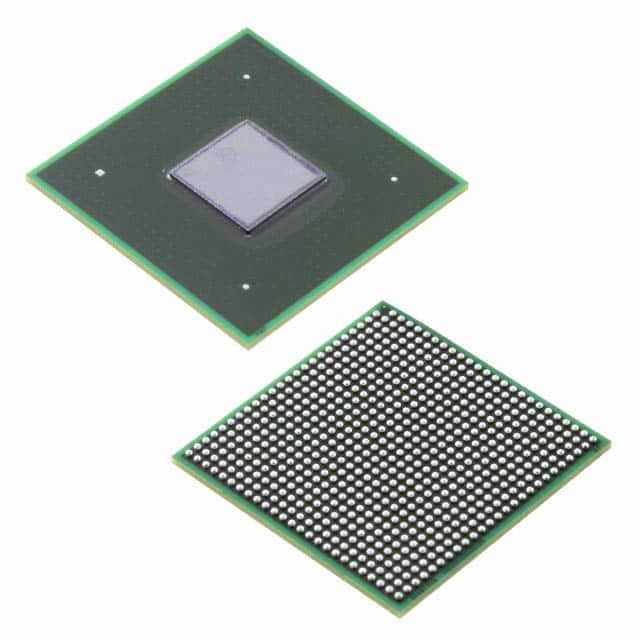MCIMX6D7CVT08AC
Product Overview
- Category: Integrated Circuit (IC)
- Use: This IC is designed for use in embedded systems and is commonly used in applications such as consumer electronics, industrial automation, automotive, and medical devices.
- Characteristics: The MCIMX6D7CVT08AC offers high performance and low power consumption, making it suitable for a wide range of applications. It comes in a compact package and provides various features to enhance system functionality.
- Package: The MCIMX6D7CVT08AC is available in a small form factor package, allowing for easy integration into different electronic devices.
- Essence: This IC serves as a central processing unit (CPU) in embedded systems, providing the necessary computing power and control capabilities.
- Packaging/Quantity: The MCIMX6D7CVT08AC is typically sold in reels or trays, with a specific quantity per package.
Specifications
- Processor: ARM Cortex-A9
- Clock Speed: Up to 1 GHz
- Cache Memory: L1: 32 KB instruction cache, 32 KB data cache; L2: 512 KB
- Operating Voltage: 1.0V - 1.3V
- Operating Temperature: -40°C to +85°C
- Interfaces: USB, Ethernet, SPI, I2C, UART, GPIO
- Memory Support: DDR3, LPDDR2, NAND Flash, eMMC
- Graphics Processing Unit (GPU): Vivante GC2000
- Package Type: BGA (Ball Grid Array)
Detailed Pin Configuration
The MCIMX6D7CVT08AC has a total of 289 pins. Here are some of the key pin functions:
- Pin 1: VDD_ARM - Power supply for the ARM core
- Pin 2: VDD_SOC - Power supply for the system-on-chip (SOC)
- Pin 3: GND - Ground reference
- Pin 4: USBOTGID - USB On-The-Go ID pin
- Pin 5: USBOTGVBUS - USB On-The-Go VBUS power supply
- Pin 6: UART1_TXD - UART1 transmit data
- Pin 7: UART1_RXD - UART1 receive data
- Pin 8: I2C1_SCL - I2C1 serial clock
- Pin 9: I2C1_SDA - I2C1 serial data
- Pin 10: GPIO1_IO01 - General-purpose input/output pin
Please refer to the datasheet for a complete pin configuration diagram.
Functional Features
- High-performance ARM Cortex-A9 processor for efficient computing
- Low power consumption for energy-efficient operation
- Support for various memory types, enabling flexible storage options
- Multiple interfaces for seamless connectivity with other devices
- Integrated graphics processing unit for enhanced visual capabilities
- Robust operating temperature range for reliable performance in different environments
Advantages and Disadvantages
Advantages: - High performance and low power consumption - Versatile interfaces for easy integration - Compact package size for space-constrained applications - Wide operating temperature range for diverse environments - Support for various memory types for flexible storage options
Disadvantages: - Limited pin count may restrict the number of peripherals that can be connected directly - Requires additional external components for complete system implementation - Higher cost compared to lower-end microcontrollers
Working Principles
The MCIMX6D7CVT08AC operates based on the ARM Cortex-A9 architecture. It executes instructions and performs calculations to carry out the desired tasks in an embedded system. The processor communicates with other components through various interfaces, enabling data transfer and control operations. The integrated graphics processing unit enhances the visual capabilities of the system, allowing for smooth rendering of graphics and multimedia content.
Detailed Application Field Plans
The MCIMX6D7CVT08AC is widely used in various application fields, including:
- Consumer Electronics: Smartphones, tablets, smart TVs, and multimedia devices.
- Industrial Automation: Factory automation systems, robotics, and control systems.
- Automotive: In-vehicle infotainment systems, navigation systems, and driver assistance systems.
- Medical Devices: Patient monitoring systems, medical imaging equipment, and diagnostic devices.
Detailed and Complete Alternative Models
- MCIMX6D5EYM10AC
- MCIMX6D6AVT10AC
- MCIMX6D7CVM10AC
- MCIMX6D8CVT10AC
- MCIMX6D9CVM10AC
These alternative models offer similar functionality and performance characteristics to the MCIMX6D7CVT08AC, providing options
Lista 10 Vanliga frågor och svar relaterade till tillämpningen av MCIMX6D7CVT08AC i tekniska lösningar
Sure! Here are 10 common questions and answers related to the application of MCIMX6D7CVT08AC in technical solutions:
Q: What is MCIMX6D7CVT08AC? A: MCIMX6D7CVT08AC is a high-performance System-on-Module (SoM) based on the NXP i.MX6 Dual processor, designed for embedded applications.
Q: What are the key features of MCIMX6D7CVT08AC? A: Some key features include dual-core ARM Cortex-A9 processors, up to 1GHz clock speed, integrated GPU, support for multiple operating systems, and various connectivity options.
Q: What kind of applications can MCIMX6D7CVT08AC be used for? A: MCIMX6D7CVT08AC is suitable for a wide range of applications such as industrial automation, medical devices, multimedia systems, IoT gateways, and automotive infotainment.
Q: What operating systems are supported by MCIMX6D7CVT08AC? A: MCIMX6D7CVT08AC supports popular operating systems like Linux, Android, and QNX, providing flexibility for different application requirements.
Q: What interfaces are available on MCIMX6D7CVT08AC? A: It offers a variety of interfaces including USB, Ethernet, HDMI, CAN, UART, SPI, I2C, GPIO, and PCIe, enabling seamless integration with other peripherals.
Q: Can MCIMX6D7CVT08AC handle graphics-intensive applications? A: Yes, MCIMX6D7CVT08AC comes with an integrated GPU that supports 2D/3D graphics acceleration, making it suitable for graphics-intensive applications.
Q: What is the power consumption of MCIMX6D7CVT08AC? A: The power consumption of MCIMX6D7CVT08AC varies depending on the application and usage, but it is designed to be power-efficient.
Q: Can MCIMX6D7CVT08AC support real-time applications? A: Yes, MCIMX6D7CVT08AC supports real-time applications through its dual-core ARM Cortex-A9 processors and various software frameworks like Xenomai or PREEMPT-RT.
Q: Is MCIMX6D7CVT08AC suitable for battery-powered devices? A: MCIMX6D7CVT08AC can be used in battery-powered devices, but the power requirements and battery life should be carefully considered based on the specific application.
Q: Are development tools and resources available for MCIMX6D7CVT08AC? A: Yes, NXP provides a comprehensive set of development tools, software libraries, documentation, and community support to aid in the development of solutions using MCIMX6D7CVT08AC.
Please note that these answers are general and may vary depending on the specific implementation and requirements of your technical solution.


